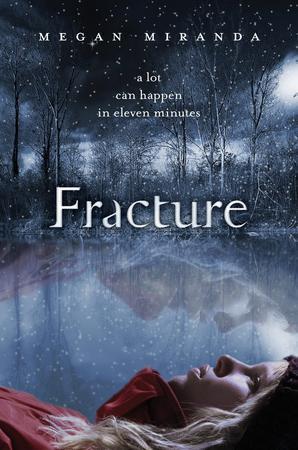 Megan Miranda is the author of “Fracture.” The following is a complete transcript of her interview with Cracking the Cover.
Megan Miranda is the author of “Fracture.” The following is a complete transcript of her interview with Cracking the Cover.
Background — Have you always wanted to write? Why?
I have always wanted to write, but I didn’t pursue it as a career until I’d switched careers once and eventually stayed home with two small children of my own—I figured writing as a job was such a dream, and I put off pursuing it for far too long. In hindsight, though, I’m glad I pursued other interests in the meantime, because I had a lot of material to pull from when I eventually started writing again.
Why write for young readers?
I love to read YA. I find that it really resonates with me emotionally. I think this is because there’s something really universal about the experiences at that age—maybe not externally, but internally. It’s such a pivotal time, when we discover who we will become. I’m really drawn to it. Also, I find that YA is a very liberating bracket to write in. You can blend genres a little more freely and not worry about where it will fit on the shelves.
Do you have any rituals? Do you write all day?
Haha, I wish. I have 2 small kids, so I’m usually doing the mom-thing during the day. I typically write at night, after they’re asleep, though my youngest started going to preschool this year, so I’m finding a few more hours in the day to get some writing done. As far as rituals, I really don’t have any. I’m pretty protective of my writing hours because they’re so limited, so I just….write J And when I get tired of writing, I read.
Where did the idea for “Fracture” come from?
I’ve always loved science, but the more I studied, the more I was drawn to the stories that science tries to explain, but isn’t always able to. I’d find myself thinking a lot about the stories of people who were supposed to die, but lived. In particular, I was drawn to the mysteries of the brain. I’d hear stories of people who got a tumor, or had a tumor removed, and their personalities changed. To me, this begged the question: which person are you? If someone is mostly the same, but something has changed, how do others treat this person? How do they see themselves? I had all these questions churning away inside of me as I wrote Fracture.
How much research was involved?
I did a lot of fact checking, and I researched hospital tests and brain recoveries as much as possible. I also tried to read first-hand accounts of people recovering from brain injuries. There was also a lot of research involved with learning how to rescue someone who has fallen through the ice (in addition to how and when that might happen).
How long did it take you to write?
It took me four months to write the first version of Fracture, very little of which made it into the finished product. I spent another 6 months rewriting (and rewriting) until I got it right.
How does “Fracture” differ as a published book from your first idea for it?
The core idea of it remains the same: a girl who survives 11 minutes trapped under ice survives but finds herself drawn to the dying. But everything else changed J Fracture became a thriller the third time I wrote it. All of the character relationships shifted. The entire plot is unrecognizable.
Delaney asks, “If you only had one day left to live, what would you do?” Have you thought about how that question relates to your own life? What would you do?
Yes, I definitely thought about it since Delaney had to think about it. Truth is, there’s not one Big Thing I would do. I’d honestly probably spend it like I spend most days: with my kids. I’d make sure to do something they absolutely loved.
 “Fracture” has a supernatural feel without really being in that genre. What is it about comas, brain injuries and the brain itself that fascinate people?
“Fracture” has a supernatural feel without really being in that genre. What is it about comas, brain injuries and the brain itself that fascinate people?
I think it’s because we know so much about nearly everything else related to the human body. We’ve mapped the human genome, we know how diseases work (even if we can’t cure them), and we know how to *fix* many different organs. But there is still so much unknown about the brain. Why do people with the same injury have completely different recoveries? How much of us (and therefore our brains) is determined by our DNA? How much of us is something more?
Delaney and Troy have decidedly different outlooks when it comes to their “miracle” survival. Why so different? And why did you decide to bring in another character who shares Delany’s “abilities”
Setting the relationship and tension between Delaney and Troy created the entire plot of the story. I did picture them much like people competing in a debate: you have the same facts, the same knowledge, but people pick different sides based on their own history and outlook. It is the polarity between the two of them that creates the tension, and that makes Fracture a thriller.
This is your first published book. Is it your first novel?
It is, but it’s the third time I wrote it.
How has your writing evolved from when you first started until now?
I’m much more conscious of the bigger picture when I’m writing. I’m usually asking myself what the purpose of a scene is while I’m writing it, and whether it’s necessary. And I try to know where the story is going before I get there… that’s not to say I still don’t have to go through multiple drafts, but at least parts of those drafts are salvageable now!
What are you working on now?
I have another standalone YA set to come out in early 2013. It’s in the same vein as Fracture in that it walks the line between science and paranormal, but it’s also pretty different. It’s a psychological thriller about the thin line between the real and the imagined.
What do you hope readers bring away from your book?
I think, once a book is published, it belongs to other people, and means different things to different people based on their experiences. If anything, though, I hope they wonder like Delaney does, whether she’s doing all she can to seize the day.
Did you have a favorite book or book that really resonated with you as a young reader?
I loved reading Michael Crichton—the way he blended science in story really resonated with me. But the first book I remember that I couldn’t get out of my head (and still can’t) was Number the Stars.
